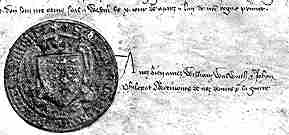



If you are looking at this page without frames, there is more information about medieval writing to be found by going to the home page (framed) or the site map (no frames).
| Royal Seals (2) | ||||
| While the basic design of the English royal great seal remained the same, the carving of the matrix became very fine and intricate and the size became larger. | ||||
 |
The front and back of the second seal of Henry IV and Henry V. | |||
| The very intricately engraved seal above was known as the gold seal; not that it was gold, but it came from a matrix which was probably silver gilt. This empahsises the point that it was really the matrix which was the significant and ceremonial object. The enthroned king has three shields of arms at his feet and is surrounded by figures of saints in canopies in an arrangement that is reminiscent of the design of funerary monuments. Seals sometimes carried from one reign to the next, and sometimes were changed in the middle of a reign. This might be for an obvious political reason, like having recently conquered France, or the reason might be lost to history. | ||||
 |
The seals of kings and magnates adorned official letters which were carried between the royal courts of Europe. Seal design crossed national boundaries as part of not only an international aesthetic, but an international system of diplomatic communication. It had to look right to do the job. The French seal at left shows the king in majesty with crown and sceptre surrounded by heraldic supporters, apparently two eagles and two lions. The seal is attached to the document with cords, in the manner of German imperial or papal documents. English royal seals were more usually attached with parchment strips. | |||
| Seal of King John II of France, on a document of 1360. | ||||
| The Vatican Library Secret Archives shows a diploma of the Emperor Frederick Barbarossa from 1164, a document which bears a gold seal attached with silk cords. It didn't get any fancier than that. | ||||
| Not only did royal seals become larger and more elaborate as the middle ages progressed, there were more of them. In England, the various types of seals which developed reflected the increasing complexity of the chancery as its functions proliferated. The privy seal appeared in the 13th century when the chancery found a permanent home away from the court, which lived on constant tour. The privy seal was used to authenticate communications from the court to the chancery. In the 14th century, the privy seal became a permanent office with its own keeper and the signet was the seal used by the king's secretary. As well, the king had his own personal signet, which may have sometimes been in the form of a ring. All of these have been referred to at times as secret seals, which sounds much more conspiratorial than it actually is. The French bureaucracy began making use of the privy seal and the signet at about the same time. | ||||
 |
The privy seal attached to the face of a document of Richard II, of 1378. It bears a heraldic design. | |||
| The privy seal and signet were single sided seals which were attached to the face of the document. Most documents which were sent out from the chancery into the great wide world were authenticated with the great seal. The privy seal and the signet were mainly used for documents passed between the secretariats and so are less likely to be found among the papers of the recipients of grants, now scattered around regional archives and private libraries. Because each seal was used by a particular secretariat or writing office within the chancery, the terms great seal, privy seal and signet are used to represent those offices and all the functions they performed, as well as referring to the particular lump of wax which they attached to their documents. | ||||
 |
The signet on an English royal warrant for payment, from 1503 (London, National Archives, E.101 415/7 m. 103). (From Jenkinson 1927, Pl.XXVI) | |||
| Note that in the example at left, a piece of paper has been placed over the wax before the seal was applied, so that the impression of the matrix appears in the paper adhering to the underlying wax. | ||||
|
|
||||
|
|
||||
|
|
||||
|
If you are looking at this page without frames, there is more information about medieval writing to be found by going to the home page (framed) or the site map (no frames). |
||||